Research Update
Today we collected sediment samples from the seafloor in an area with a polluted past: the sewage outflow site. Our divers collected sediment and organisms at three seafloor depths: 120 feet, 80 feet and 40 feet. We started out in a dive hole farther out on the sea ice at the 120 foot spot. After collecting samples there, we moved our dive hut to a closer dive hole to collect the 80 feet and 40 feet deep samples.
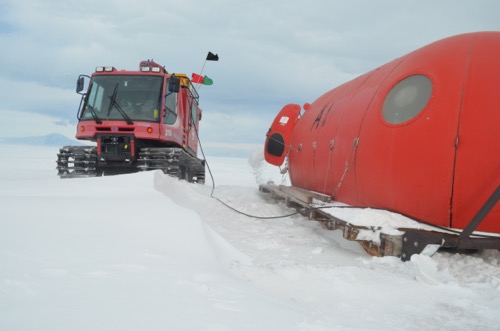 A line carrying air goes from the PistenBully to the diver's tank in the dive hut.
A line carrying air goes from the PistenBully to the diver's tank in the dive hut.
A Need for Protective Gear
Divers have to wear special gear when collecting samples at this site. They wear a vulcanized Hazmat diving suit and a hard hat, which encloses the diver's whole face and allows the diver to communicate with those above through an "umbilical" cord.
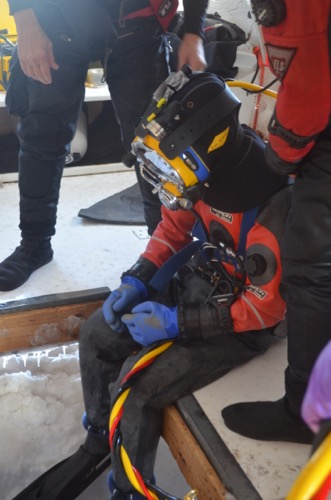 Terry Palmer wears a vulcanized diving suit and a hard hat for a dive into dirty water. Note the yellow, red and black umbilical cord which supplies air and a means of communication.
Terry Palmer wears a vulcanized diving suit and a hard hat for a dive into dirty water. Note the yellow, red and black umbilical cord which supplies air and a means of communication.
After returning to the surface, the diver is sprayed with a solution of bleach and Betadine (an antiseptic). The divers also wash off with hot water and soap when they return from their dive.
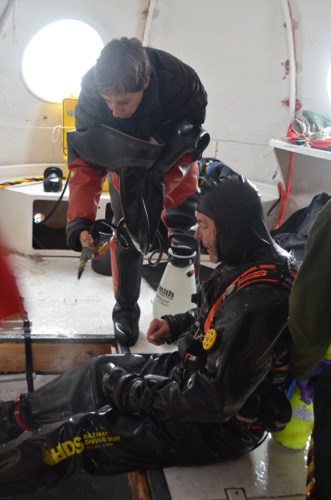 Brenda Konar sprays Steve Rupp,'s Hazmat diving suit with bleach and antiseptic after a dive at the sewage outfall.
Brenda Konar sprays Steve Rupp,'s Hazmat diving suit with bleach and antiseptic after a dive at the sewage outfall.
Why do the divers take so many precautions while diving? Because this site has sewage at the bottom of it, creating a health risk if the divers do not wear proper gear.
A Polluted Past, A Hopeful Future
Before 2003, solid waste was broken up and deposited into the sewage outfall area. Sewage would pile up in front of the outfall pipe and divers would have to clear it off with a hose.
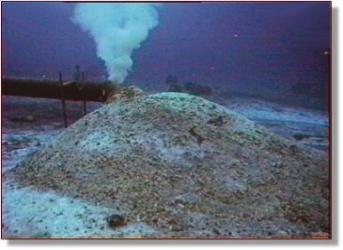 The sewage outfall pipe before 2003 in McMurdo Sound. Photo courtesy of Rob Robbins.
The sewage outfall pipe before 2003 in McMurdo Sound. Photo courtesy of Rob Robbins.
A wastewater treatment plant was built to remedy this situation. In 2003 it began compressing solid waste which could be shipped back to the United States instead of flowing into McMurdo Sound.
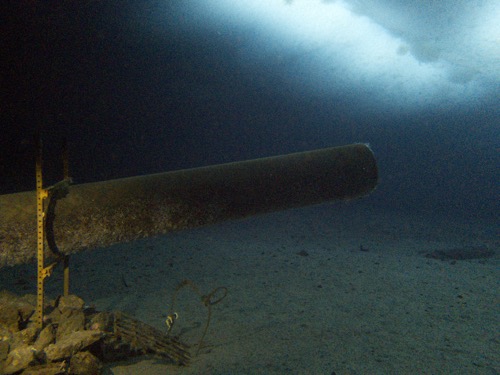 The same sewage outfall pipe today has little to no waste flowing out of it. Photo courtesy of Rob Robbins.
The same sewage outfall pipe today has little to no waste flowing out of it. Photo courtesy of Rob Robbins.
Since the Waste Water Treatment Plant started processing solid waste, hardly anything is deposited at the outflow site. Although past waste is still present, a mat of bacteria covers the area. Scavengers, such as sea stars, are abundant along with polychaete worms.
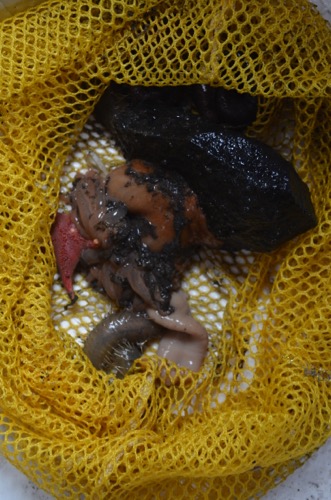 A sea star, anemone, a nemertean worm, and a flabelligerid worm are collected from the outfall site.
A sea star, anemone, a nemertean worm, and a flabelligerid worm are collected from the outfall site.
Critical Thinking
Why do the divers get sprayed with bleach and antiseptics after they come up from the water? What might happen if they don't spray themselves after diving in the sewage outfall area?
How to Flag a Hole
A few students have asked how to put a flag in the sea ice to mark the dive holes in the Ask the Team section of the journal (by the way, thank you and keep the questions coming!). I thought some pictures might help explain things:
 Step 1: Move the dive hut away from the dive hole you have finished diving in.
Step 1: Move the dive hut away from the dive hole you have finished diving in.
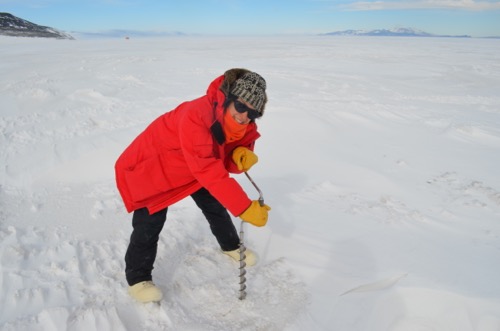 Step 2: Drill hole in the sea ice using an auger.
Step 2: Drill hole in the sea ice using an auger.
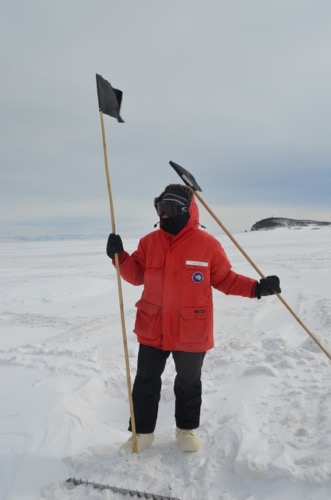 Step 3: Put a black flag in the hole to signal danger.
Step 3: Put a black flag in the hole to signal danger.
Life in Antarctica
Although our work here is very different from a typical day back home, there are aspects of life that feel familiar. The other day I had the opportunity to get a haircut at McMurdo Station.
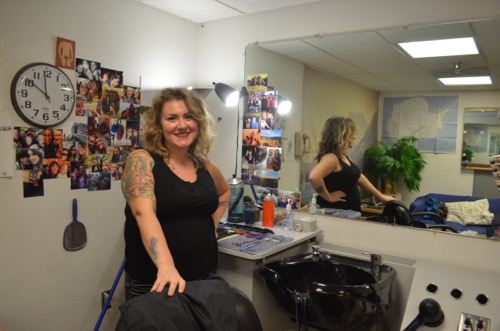 Alicia is prepared to give me a haircut at the "salon" in McMurdo Station.
Alicia is prepared to give me a haircut at the "salon" in McMurdo Station.
Alicia was a hairstylist in Portland, Oregon when she heard about the opportunity to live and work in Antarctica. She worked in the kitchen at McMurdo Station for two years and last year was invited to return as a hairstylist. This is her second year cutting hair in Antarctica. Haircuts can be arranged by appointment or as a walk-in on certain days. They only cost $10!
Ice POD
Today's Ice Picture of the Day compares the seafloor from the past with the seafloor today. You can download a PowerPoint Slide of the Ice POD by clicking here: 14_icepod.pptx
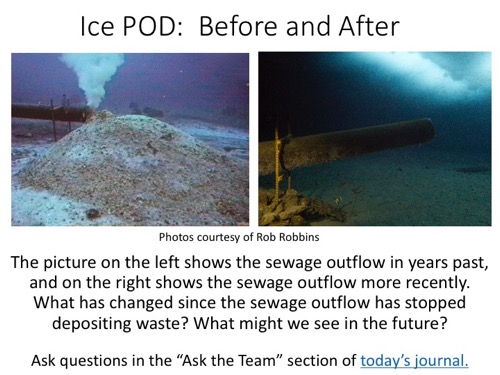 The Ice Picture of the Day compares the sewage outflow from the past and present. Photos courtesy of Rob Robbins.
The Ice Picture of the Day compares the sewage outflow from the past and present. Photos courtesy of Rob Robbins.
Brought to you by...
Today's journal is brought to you by Mrs. Palmer's class in Papamoa School, New Zealand. Terry proudly holds the penguin in the dive hole!
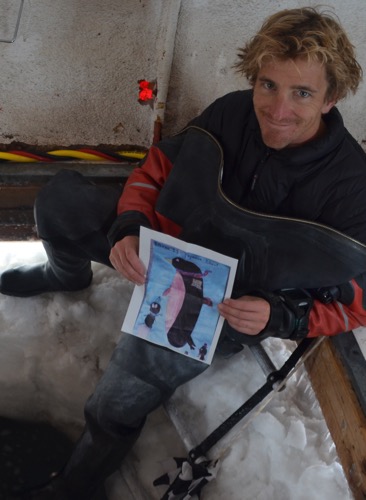 Today's journal was brought to you by Mrs. Palmer's class at the Papamoa School in New Zealand.
Today's journal was brought to you by Mrs. Palmer's class at the Papamoa School in New Zealand.
Comments